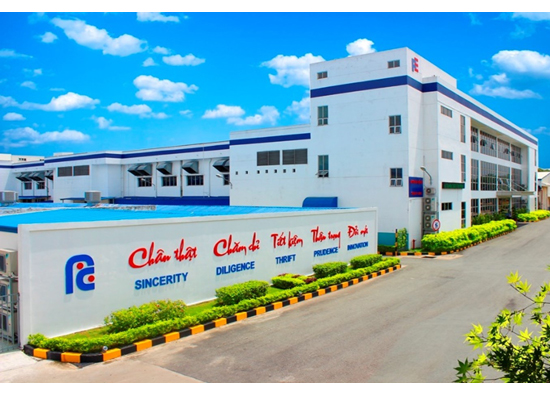11.2024 Cover Story
Everest Textile focuses on green weaving to add value to the brand
Everest Textile / Li Meilian


 With the threat of climate change gradually approaching, energy conservation, carbon reduction, and energy transformation have become global common goals. Countries have successively put forward declarations and actions of "2050 net zero emissions", and Taiwan has also released a 2050 net zero carbon emissions roadmap, working together for the sustainability of the earth. Everest Textile's operational bases span across Asia, America, and Africa, possessing the advantages of flexible operations and complete product structure. With innovative technological capabilities and vertically integrated smart manufacturing plants, it actively aligns with international sustainability development trends, providing multifunctional and environmentally friendly innovative products, demonstrating the sustainable business energy of valuing environmental protection (E), social responsibility (S), and corporate governance (G).
With the threat of climate change gradually approaching, energy conservation, carbon reduction, and energy transformation have become global common goals. Countries have successively put forward declarations and actions of "2050 net zero emissions", and Taiwan has also released a 2050 net zero carbon emissions roadmap, working together for the sustainability of the earth. Everest Textile's operational bases span across Asia, America, and Africa, possessing the advantages of flexible operations and complete product structure. With innovative technological capabilities and vertically integrated smart manufacturing plants, it actively aligns with international sustainability development trends, providing multifunctional and environmentally friendly innovative products, demonstrating the sustainable business energy of valuing environmental protection (E), social responsibility (S), and corporate governance (G).
1、 Carbon reduction strategies to address climate change
Faced with the challenge of extreme climate, Everest Textile has taken multiple carbon reduction measures, from process production to building energy efficiency, and then to low-carbon product design, comprehensively promoting energy conservation and emission reduction.

1. Carbon reduction measures in process production
In the textile industry, the main source of carbon emissions is coal combustion. Everest Textile uses some biofuels instead of coal and plans to fully promote the conversion of coal-fired boilers to natural gas (LNG) boilers by 2024. At the same time, it will install solar power generation equipment in its Taiwan plant, hoping to use green energy and reduce dependence on purchased electricity. In terms of equipment updates, Everest Textile will reduce its carbon emissions by approximately 1481 tons by replacing old with new in 2023.
2. Low carbon product design
Everest Textile actively promotes carbon reduction and environmental protection measures in product development, including purchasing green and environmentally friendly raw materials, developing sustainable products, and emphasizing product recycling. For example, Ever Bio3 CCU Polyester uses Far Eastern New Century Corporation's industrial waste gas capture fibers and combines with Everest Textile's core expertise to develop Ever Carbon Capture Wicking products, further reducing the product's carbon footprint.
2、 Sustainability Development and Green Product Development
 Everest Textile deeply understands the importance of sustainability development, with sustainability and innovation at its core, developing diverse green products to respond to market demand and environmental trends.
Everest Textile deeply understands the importance of sustainability development, with sustainability and innovation at its core, developing diverse green products to respond to market demand and environmental trends.
1. Raw material procurement and product design
In terms of raw material selection, Everest Textile prioritizes purchasing materials that meet environmental standards such as "recyclable," "renewable," and "decomposable," and collaborates with suppliers to ensure the use of materials that comply with Bluesign ® Standard The blue marked dye and additives reduce the negative impact on the environment. In terms of product design, emphasis is placed on sustainability and environmental friendliness, using materials such as organic cotton and recycled fibers, and developing biodegradable PET&Cotton products to reduce the generation of non biodegradable waste.
2. New product development
Everest Textile actively promotes recycled economy and has developed new products such as PET bottle recycling film, single material bonding, water-based coating bonding, etc., which have been widely recognized in the market and have repeatedly won awards at the ISPO outdoor goods exhibition in Germany.
3. Green supply chain and social responsibility
Everest Textile strengthens its cooperation with local suppliers, promotes green supply chain management, prioritizes the use of materials that meet sustainable standards, and reduces hidden risks and environmental burdens in the global supply chain by increasing the proportion of local production.
3、 Cross disciplinary cooperation opportunities brought by the sports trend
 In recent years, the trend of sports has emerged, and consumers' demand for functionality and fashion has been increasing, providing value-added opportunities for the textile industry. Through cross-border cooperation with various industries, Everest Textile has successfully expanded the application scope of its products and added new value to the brand.
In recent years, the trend of sports has emerged, and consumers' demand for functionality and fashion has been increasing, providing value-added opportunities for the textile industry. Through cross-border cooperation with various industries, Everest Textile has successfully expanded the application scope of its products and added new value to the brand.
1. Cross border cooperative development
Everest Textile has partnered with chemical giant BASF to develop tire recycling woven elastic fabric, which has won the favor of a well-known German racing sponsor brand. The plan is to hand over the recycled racing tires to BASF for development, and then use Everest Textile to make racing clothing fabric, becoming an example of cross industry cooperation.
2. Integration of Fashion and Sports
Everest Textile has collaborated with trendy brands to develop clothing that combines fashion and sports functionality. With prints that have special visual effects, combined with moisture wicking, antibacterial, odor resistant, UV resistant, and other functions, it not only attracts fashion enthusiasts but also enhances the brand's added value and market awareness.
3. Promote Sustainability Development
Everest Textile actively responds to the environmental movement by collaborating with environmental organizations to develop eco-friendly sportswear made from renewable resources or recycled materials, and organizing green events such as beach cleaning to strengthen its social responsibility image.
Through these cross-border cooperation strategies, Everest Textile not only has access to new information in different fields, but also enhances its innovation capabilities by applying a single material to the development of products with different functions, expanding market coverage, and meeting consumers' demands for diversity and innovation. In addition, Everest Textile combines the fashion elements of designers with the technological advantages of the textile industry, successfully enhancing its fashion value while maintaining product functionality and comfort.
4、 Intelligent Transformation in the AI Era
Since the end of 2014, Everest Textile has been committed to promoting digital transformation and has gradually added the following smart automation devices to reduce human workload.
1. Automation of dyeing and finishing agents
Türkiye ENMOS automatic weighing system and Luya's automatic weighing auxiliary system were introduced to integrate the central control of different types of dyeing machines, and the MES system was connected in series. After the operator swipes the process card weighing barcode, the fabric is fed into the dyeing tank and the dyeing tank is closed. The Taichung City control will automatically call the MES system to transmit the weighing data and dyeing machine parameter information back to the central control system for subsequent automatic weighing and dyeing operations.
2. Finished fabric AI quality assurance
In traditional manufacturing processes, after fabric sample production, quality assurance personnel need to inspect and record defects one by one, which not only consumes manpower but also easily leads to missed judgments due to visual fatigue, resulting in customer complaint risks. Everest Textile has introduced Israel's EVS smart fabric inspection system, which uses high-speed cameras to capture and detect AOI defects on the fabric surface, locate the defect location, and then move the spectrometer left and right to analyze color difference. This not only reduces labor requirements but also increases productivity by 30%.
3. Smart membrane production system
Everest Textile has collaborated with Industrial Technology Research Institute and Advantech Technology to develop an AIoT (Internet of Things) system that combines AI (Artificial Intelligence) with IoT (Internet of Things). This system is specifically designed for Everest Textile and can be used in the production process of waterproof and breathable membranes. Through an online monitoring system using sensors, the production parameters of waterproof and breathable membranes can be monitored, and a production history tracking and query system can be established to ensure product quality. Its biggest advantage is the application of AI's powerful machine deep learning capabilities to membrane making equipment, training cloud based machine deep learning to generate AI judgments with data analysis capabilities, achieving the goal of integrating intelligent technology with textiles.
In the future, Everest Textile plans to incorporate more high-end smart technologies, such as collaborating with related companies Far EasTone Telecommunications, Far Eastern Group, YDT Technology International, and InFROTION Security Service Digital United to promote 5G dedicated frequency and network solutions, establish intelligent logistics unmanned vehicle (AGV) systems in the factory area, and introduce Far Eastern Group's new 5G intelligent industrial remote security protection application system. Through image AI recognition technology, potential security risks can be avoided and the incidence of work safety accidents can be effectively reduced. On the other hand, generative AI Copilot applications will also be introduced. Seed personnel from various business units will undergo training and practice together according to the project theme, and share and disseminate the results SOP to improve work efficiency.
#


















